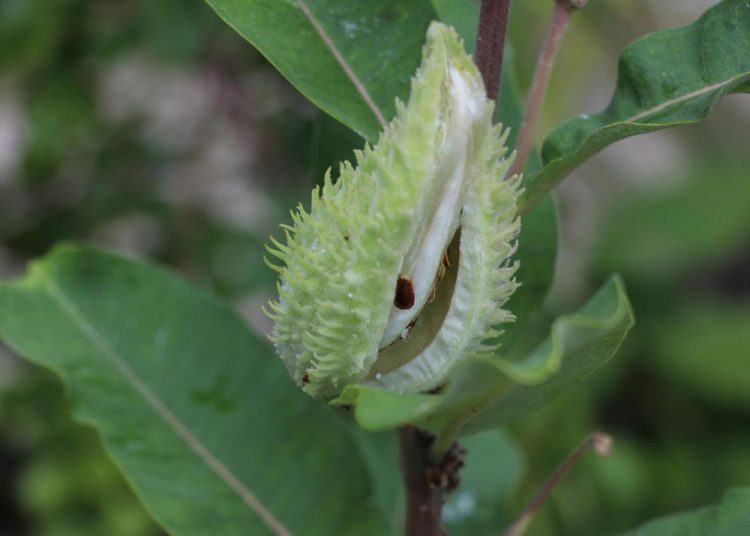Grassland biodiversity is blowing in the wind

Spillover from remnant grasslands enhances plant diversity in restorations but the effect is context dependent and driven by wind-dispersed seeds, such as milkweed. Credit: University of Missouri
“There are many benefits for why we should care about grasslands. They provide food for livestock, habitat for wildlife, prevent soil erosion, support pollinators, and capture a lot of the world's carbon. These benefits derive primarily from the diverse grasses and flowering plants that comprise grassland communities. When we lose that diversity, we risk losing those benefits,” said Lauren Sullivan, a grassland ecologist with the Division of Biological Sciences. “We found that spillover, especially of wind-dispersed plant species, is an important means for promoting biodiversity in restored grasslands.”
Ecologists describe spillover as the natural movement of species from one habitat to another. The concept is commonly associated with marine habitats, where fish spillover from protected areas can be used to improve adjacent fisheries. Unlike fish, plants rely on external forces, like wind and animals, to move their seeds. Where seeds land also can determine whether they will grow.
“Because plant dispersal and establishment depend not only on who's producing seed but also where the seed is landing, we wanted to know whether and under what conditions spillover could be used to increase biodiversity in grassland systems,” said Sullivan.
To do this, Sullivan and her colleagues studied restored prairies that are adjacent to remnant prairies in northwest Minnesota. They included restored prairies with varying levels of diversity. To measure spillover, they cataloged every plant species across the entirety of the remnant site and then in the adjacent restored prairie up to 400 feet from the boundary between the prairies.
Plant species included in the original seed mix for the restored prairie were removed from the list, leaving only species that could have arrived by spillover. They examined whether the species richness of the restored prairies and individual plant dispersal traits affected the spillover they observed.
The researchers found evidence of spillover in restorations seeded with a low diversity of species. They also found more spillover of wind-dispersed species than those dispersed by animals or passive mechanisms. They concluded that spillover from remnant prairies is an important factor increasing biodiversity in restored grasslands, but that context matters.
“In the case of grassland ecosystems, we found spillover depends on who you are and where you land. If you have movement mechanisms that allow you to travel further, like wind, you are more likely to spillover and if you are landing in a low diversity environment you are more likely to establish,” said Katie P. Sperry, who led the project and is first and corresponding author of the new study. “Importantly, spillover represents a source of species not typically included in seed mixes, such as several members of the daisy and milkweed families.”
The research and its findings are highlighted in an Applied Ecologists Blog authored by Lars Brudvig with Michigan State University. According to Brudvig, strategically installing restorations adjacent to remnant grasslands and prioritizing plant species that do not arrive by spillover in seed mixes are two practical applications of the research. “The findings [also] illustrate the broad importance of landscape considerations during restoration and illustrate that connectivity-driven spillover effects may explain some of the variation we observe among restoration efforts.” Brudvig was not affiliated with the study.
###
The study, titled “Species diversity and dispersal traits alter biodiversity spillover in reconstructed grasslands,” appears in the Journal of Applied Ecology.
Additional authors are Haley Hilfer and Ian Lane with the University of Minnesota; Jessica Petersen with the Minnesota Department of Natural Resources; and Philip M. Dixon with Iowa State University.
Media Contact
All latest news from the category: Life Sciences and Chemistry
Articles and reports from the Life Sciences and chemistry area deal with applied and basic research into modern biology, chemistry and human medicine.
Valuable information can be found on a range of life sciences fields including bacteriology, biochemistry, bionics, bioinformatics, biophysics, biotechnology, genetics, geobotany, human biology, marine biology, microbiology, molecular biology, cellular biology, zoology, bioinorganic chemistry, microchemistry and environmental chemistry.
Newest articles

Properties of new materials for microchips
… can now be measured well. Reseachers of Delft University of Technology demonstrated measuring performance properties of ultrathin silicon membranes. Making ever smaller and more powerful chips requires new ultrathin…

Floating solar’s potential
… to support sustainable development by addressing climate, water, and energy goals holistically. A new study published this week in Nature Energy raises the potential for floating solar photovoltaics (FPV)…

Skyrmions move at record speeds
… a step towards the computing of the future. An international research team led by scientists from the CNRS1 has discovered that the magnetic nanobubbles2 known as skyrmions can be…





















